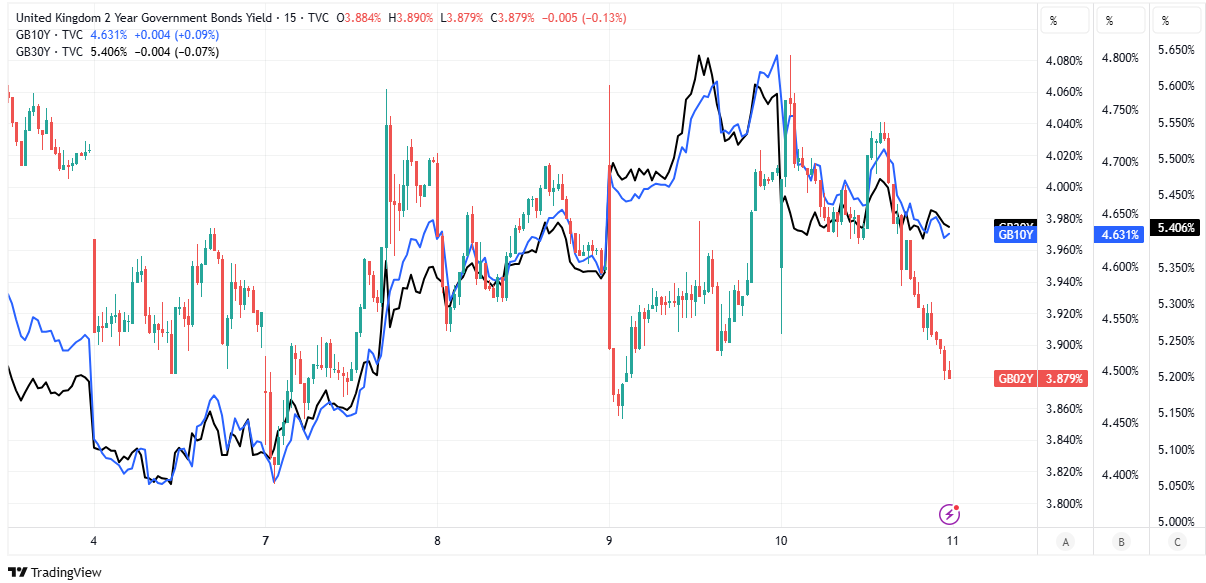
Image © Adobe Images
Sterling Gilts and US Treasuries rebounded on Thursday following earlier across the curve weakness that was incongruous with the then-global bid for government bonds, but the risk of episodic bouts of weakness lingers due to pressure on the Chinese Renminbi and prospect of further interventions in support of the currency.
British 2, 10 and 30-year bonds recovered earlier lost ground on Thursday, leading short, medium and long-term financing costs for the taxpayer to fall, while US Treasuries rose across the curve during trading in Tokyo and London, before the longer parts of the maturity spectrum softened in North American trade.
This followed President Donald Trump’s late-Wednesday decision to reduce his newly-adopted global reciprocal tariff to 10% and delay its implementation for a period of 90-days, while raising the new levy on imports from China to some 145% in what has quickly become a tit-for-tat trade spat.
However, the risks ahead stem from the fact that this hasn’t stopped the sell-off in the US equity markets and US Dollar exchange rates, but has intensified the pressure on the Chinese currency, leading numerous important Renminbi pairs to fall below their permissible floors on Thursday, as others tested theirs.
"USDCNH held the retracement back below 7.40 yesterday, with today’s fixing supporting the view that the PBoC will only allow very gradual RMB depreciation,” says Matt Atherton, a director of FX sales at Goldman Sachs.
Above: GB 2, 10 and 30-year bond yields at 15-minute intervals. Click for closer inspection.
“Flow wise, trading [colleagues] have highlighted that what was most notable during [Wednesday’s] session was the heavy offers observable in the [USD/CNH] market despite franchise flow still skewed towards USD demand. We suspect the majority of which was local offers,” Atherton adds, in a Thursday market commentary.
Renminbi losses have clearly forced the People’s Bank of China to intervene in order to temper the depreciation, and some of its interventions have almost certainly been funded by sales of US Treasuries, partly because USD/CNY is the most effective, and cost effective, vehicle in the current circumstances.
Such interventions are almost the only thing that could explain the decline of USD/CNY into the Asia close on Thursday, and the persistent decline of USD/CNH, which has now realigned with USD/CNY and they are the only viable way for Beijing to temper the parabolic rallies in EUR/CNY, JPY/CNY and CHF/CNY.
All of this is relevant to the Gilt market because Sterling bonds often display a high sensitivity to, and strong correlation with US Treasuries, and the FX interventions are of heightened importance because of deteriorating US-China trade relations, which are setting the stage for a lengthy period of persistent interventions.
“If recent disruption in the US Treasury market continues we see no other option for the Fed but to step in with emergency purchases of US Treasuries to stabilize the bond market. This would be very similar to the Bank of England intervention following the gilt crisis of 2022,” says Ting Lu, an economist at Nomura.
Persistent interventions would be troublesome if they bring about further episodes of weakness in the Treasury market, which could lead to lasting side-effects, and that risk is rising because the recent price action has already led to the formation of unhelpful trading rules and assumptions among some market professionals.
Above: US 2, 10 and 30-year bond yields shown at 15-minute intervals. Click for closer inspection.
“We're inclined to view higher yields as an ongoing risk ahead. We've had too much risk-off in recent days that has not correlated with lower yields. So there is still an implicit negative tint attached to Treasuries. That's not shaken yet,” says Padhraic Garvey, CFA and Americas head of rates research at ING.
“Our impression from here is the 10yr Treasury yield will have a tendency to head for the 4.5% area, potentially with a view to thinking about 4.75%. The March US budget numbers are not awful, but still not great. The running deficit has widened to US$1.3tn,” he adds.
These unhelpful rules and assumptions risk becoming poisonous mythologies, if widely adopted, in a chain reaction similar to what happened in the Gilt market during September 2022 and thereafter, which is pertinent now that any amicable agreement between Washington and Beijing appears further away than ever.
That’s because the bellicose and tactless approach often taken by the White House is making talks and negotiations all but impossible for a Chinese psychology and mindset that cannot countenance the idea of even being seen to bow, bend a knee, or beg before a would-be imperial ‘master.’
Many officials in Beijing, and Chinese more broadly, would sooner cut off their own heads, and those sentiments shouldn't be difficult for Americans to understand.


